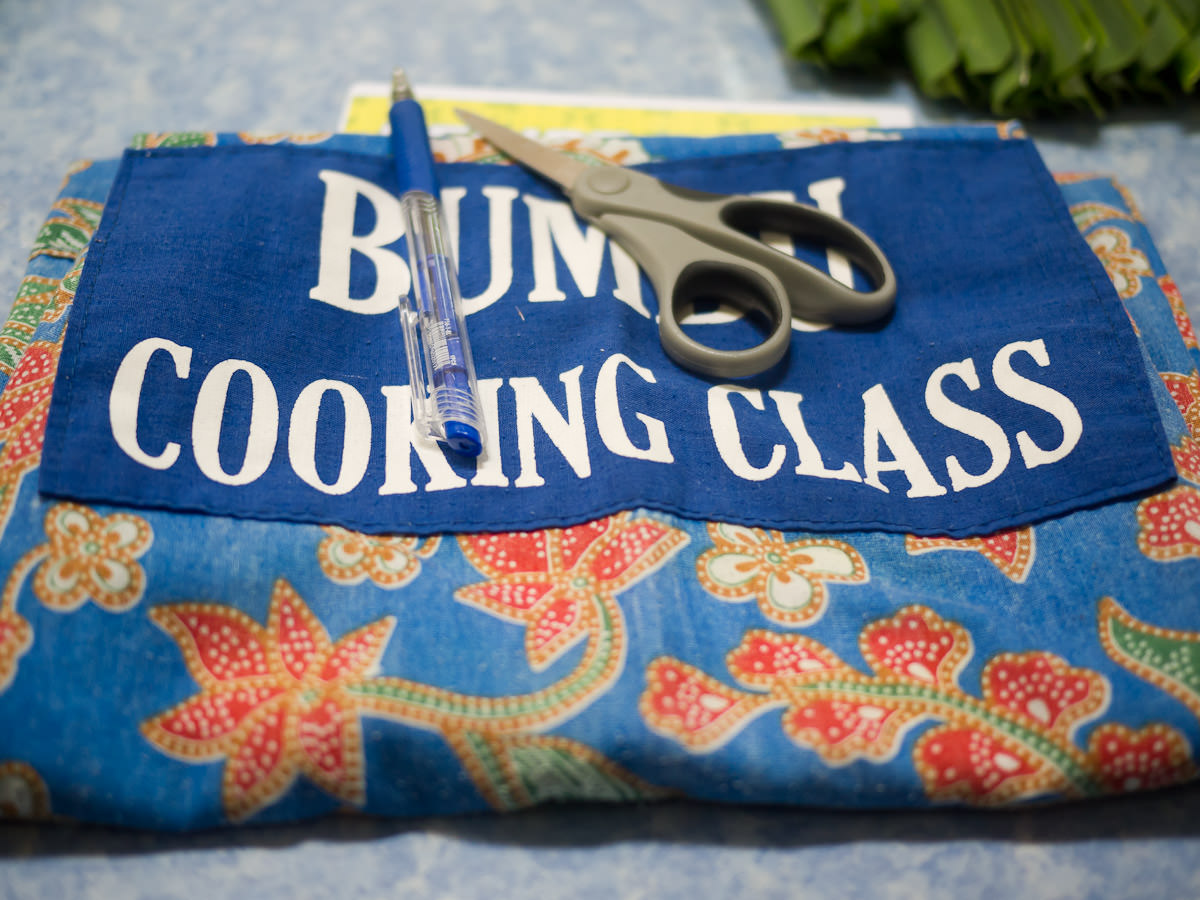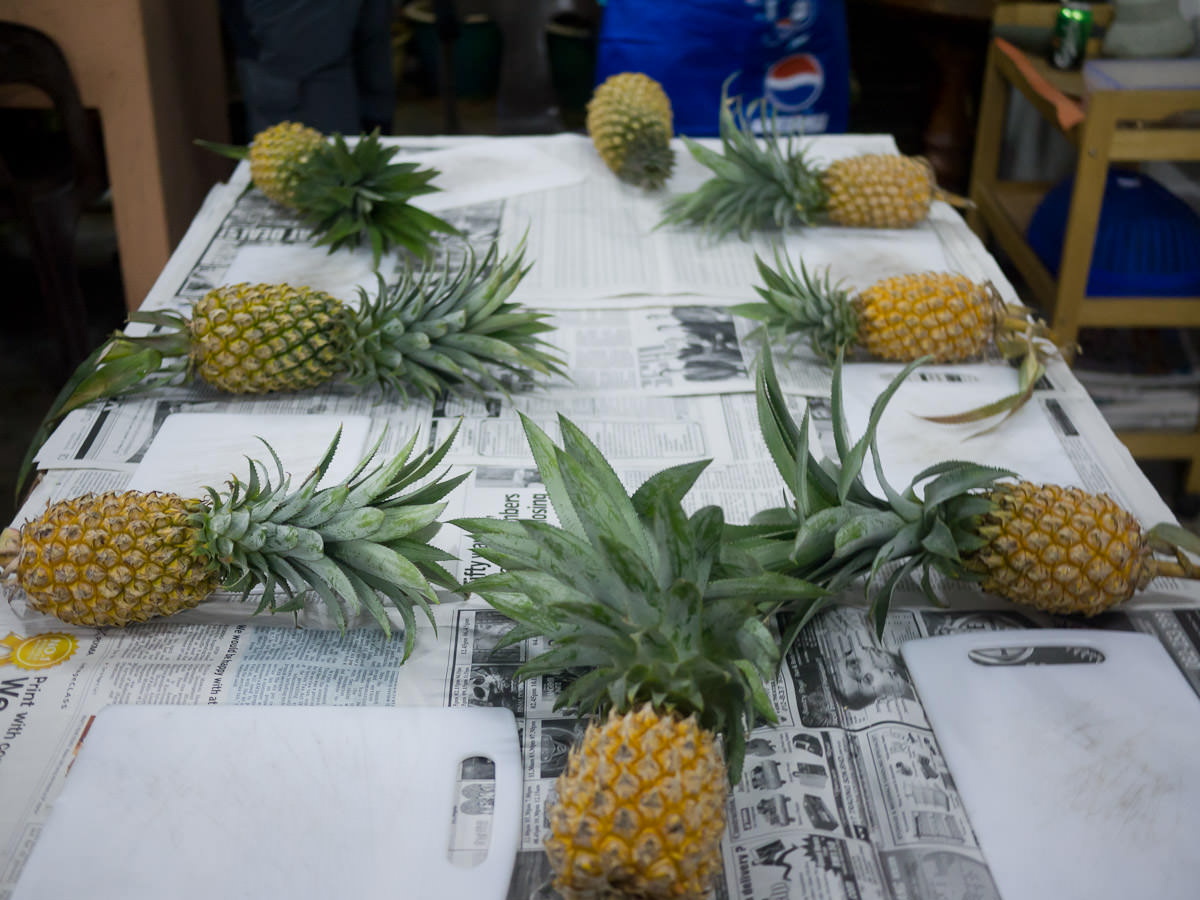Bumbu Cooking Class, Kuching
With our baskets full of fresh ingredients purchased from Satok Market, we head back to Bumbu Cooking Class to cook our own Malaysian dinner. The class is led by the lovely Richa, who is our Kuching guide Joseph’s sister. Her assistant Nora also helps throughout the class.
Richa welcomes us to her “simple home kitchen”. It’s going to be a hands-on class – with Richa and Nora’s guidance, we’ll be the ones doing all the cooking. At the end of the class, we’ll all sit down to eat the meal we’ve cooked.
We all put on our aprons and wash our hands. As we start the class, rain starts to fall outside, clattering loudly on the tin roof. By the sound of it, it’s lucky we plan to be indoors for a while.
We start on the dessert first – kuih tako. Richa and Nora demonstrate how to make little baskets out of fresh pandan leaves. The kuih tako will go into these little baskets.
The pandan baskets all made, we then squeeze fresh coconut to make coconut milk.
We thicken the coconut milk mixture with green pea flour, a product none of us have come across before (Richa tells us cornflour can be used as a substitute) and add water and sugar. We add spoonfuls of corn kernels to our pandan baskets, then add the coconut mixture. The kuih tako are then placed in the fridge to chill and set.
We get on to cooking the main course, rendang ayam (chicken rendang – “ayam” is “chicken” in Malay). First, we toast fresh coconut in our woks over portable gas burners.
We toss the coconut constantly until it turns brown and wonderfully fragrant. I forget all about the noisy rain as our “wok chuan” (metal spatulas) clank against the woks. Ever since I was a child I’ve thought that is one of the best sounds in the world – it never fails to make me hungry.
Richa explains we are going to make our own rempah (spice paste) for the rendang. We pound fresh lemongrass, galangal, ginger, shallots and chopped dried chillies.
As my arms start to ache, I think about how I used to listen to my grandma pounding away with her pestle and mortar making rempah in our kitchen. I never really appreciated how much work it was to do it all by hand. Our instructors acknowledge that rempah could be made using a food processor but they firmly believe that the resulting paste is better when made in the traditional way – pounded by hand.
It’s worth the effort though. We add other items to the wok – salt, sugar, tamarind, tumeric leaf, and of course, the toasted coconut. The rendang ayam looks and smells delicious! J’s fish curry made with fresh mackerel and an assortment of vegetables bought from the market looks and smells wonderful too (sorry, no picture).
While the rendang simmers, Joseph teaches us how to slice pineapple Asian-style. We each have our own pineapple and knife so we can have a go at slicing pineapple ourselves.
I’d like to blame my pathetic efforts on a pineapple that was misshapen to begin with but I suspect my terrible first-time cutting skills are to blame! But overall we don’t do too badly for a first effort.
As our rendang is almost ready, it’s time to prepare the vegetable dish. Midin grows wild in swampy forests in Sarawak and is known locally as “jungle ferns”. If you ever visit Sarawak, midin is a must-try specialty. I first ate midin at Top Spot food court on my first night in Kuching and am excited to have the chance to cook my own.
We remove the rafia string and unravel our leaf-wrapped bundles of midin, which we wash under running water. Then it’s time for more pounding as we make our own sambal belacan, combining dried chillies, shallots, dried shrimps and belacan (shrimp paste).
If you want the midin “crispy” – it only takes a few minutes to stir-fry. If you want it soft, stir-fry it for longer. We’re all starving by now and most of us choose crispy! The deliciously spicy pungent aroma of belacan fills the air.
This is another one of those moments I wish we had Internet Smellovision.
As the others plate up their midin and come to sit at the dining table, I lift the lid of my pot to sneak another greedy peek at my rendang. It looks and smells delicious!
Dinner is served, and we feel like we’ve truly earned it.
Regular readers will know I’m more an eater than a cook. As I eat my dinner, I can’t help feeling proud of myself. I can’t believe that I cooked this (under the supervision of our instructors, of course)!
There are also local fruits to eat, including the pineapple we sliced earlier.
Last of all, the kuih tako. It’s sweet and cold, with a gelatinous texture and the pleasurable pop of corn kernels.
Bumbu Cooking Class
57 Carpenter Street, Kuching, Sarawak
Minimum 2 people
Prior reservation is essential – contact Joseph on 019 8791050
Class includes:
- Guided walk to market – you’ll especially love this if you enjoy taking photographs
- All cooking ingredients.
- Hands-on, individual cooking.
- Recipe book – the “recipes” are mostly just the lists of ingredients. There is plenty of space in the supplied booklet for you to write your own notes.
- Lunch or dinner (cooked by you!).
It’s an epic cooking class that goes on for more than four hours. Be warned – making spice pastes by hand is surprisingly physically demanding if like me you use a keyboard and mouse more often than a mortar and pestle! It’s great fun, a rewarding and different way to experience Malaysia. You’ll gain a deeper appreciation for what makes a good rendang and may even be more critical of the rendang you are served in restaurants in future – the chicken rendang you cook is absolutely delicious.
TFP visited Kuching, Malaysia and attended Bumbu Cooking Class as a guest of Malaysia Kitchen, MATRADE and Tourism Malaysia.
Read the posts in my Kuching Trip 2011 series
There are more Kuching posts to come (one day’s worth of eating/activities left!).























